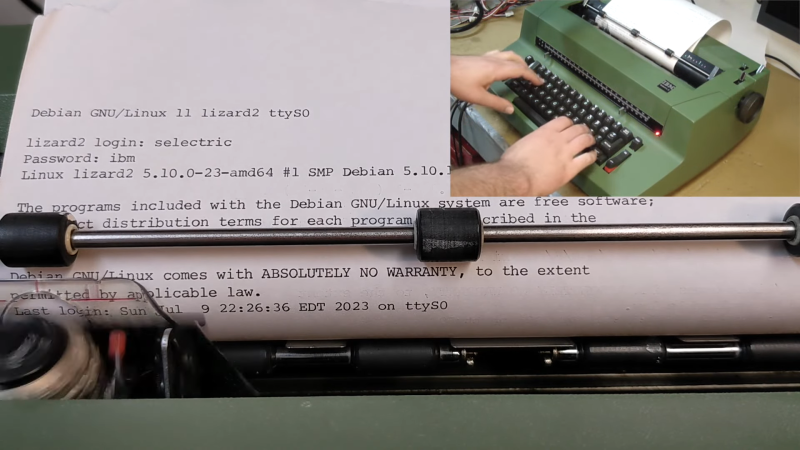If there’s only lesson to be learned from [alnwlsn]’s conversion of an IBM Selectric typewriter into a serial terminal for Linux, it’s that we’ve been hanging around the wrong garbage cans. Because that’s where he found the donor machine for this project, and it wasn’t even the first one he’s come across in the trash. The best we’ve ever done is a nasty old microwave.
For being a dumpster find, the Selectric II was actually in pretty decent shape. The first couple of minutes of the video after the break show not only the minimal repairs needed to get the typewriter back on its feet, but also a whirlwind tour of the remarkably complex mechanisms that turn keypresses into characters on the page. As it turns out, knowing how the mechanical linkages work is the secret behind converting the Selectric into a teletype, entirely within the original enclosure and with as few modifications to the existing mechanism as possible.
Keypresses are mimicked with a mere thirteen solenoids — six for the “latch interposers” that interface with the famous whiffletree mechanism that converts binary input to a specific character on the typeball, and six more that control thinks like the cycle bail and control keys. The thirteenth solenoid controls an added bell, because every good teletype needs a bell. For sensing the keypresses — this is to be a duplex terminal, after all — [alnwlsn] pulled a page from the Soviet Cold War fieldcraft manual and used opto-interrupters to monitor the positions of the latch interposers as keys are pressed, plus more for the control keys.
The electronics are pretty straightforward — a bunch of MOSFETs to drive the solenoids, plus an AVR microcontroller. The terminal speaks RS-232, as one would expect, and within the limitations of keyboard and character set differences over the 50-odd years since the Selectric was introduced, it works fantastic as a Linux terminal. The back half of the video is loaded with demos, some of which aptly demonstrate why a lot of Unix commands look the way they do, but also some neat hybrid stuff, like a ChatGPT client.
Hats off to [alnwlsn] for tackling a difficult project while maintaining the integrity of the original hardware.

















We used to have the “official” version of these – the IBM 2741 terminal – when I was at school. They were always down. Apparently, the mechanism wasn’t up to taking the abuse that college kids whose program wouldn’t run would heap upon them.
Selectrics are wonderful machines, but they can be temperamental.
We had 2741s when I was in school too. I worked in the computer center and we had to call the IBM service rep to help untangle a girl’s long hair that got caught inside the mechanism. She got it tangled as she was leaning over the top of the terminal trying to read the yellow sticker in the bottom of the carriage mechanism that said “Caution: keep hands, fingers and hair out of this area”. It was pretty funny after we got her untangled safely, and without having to cut any of her hair off.
Your school didn’t have scissors?
After using a 2741 as a terminal for my first home made CP/M computer, I made the stupid choice of dumping it when I move to another city…
I’ve used a 2741. Yes they are tempermental. And I’ve used a Selectric. Also look inside Don Lancaster’s TVT Cookbook. There he describes much of what this intrepid person did, but much better.
What happens when you run out of ribbons?
Many years ago I remember rubbing a sharpie all over a dried out old dot-matrix ribbon then printing with that.
Selectrics use a carbon film ribbon. Smacking the ball into the platen removes a bit of the carbon in the shape of the letter. This is an important plot point in the Columbo episode “Now You See Him…”, in which our intrepid detective reads the letter typed by the victim on a Selectric by unwinding the ribbon.
I thought it McCloud who did that, not Columbo.
Same trick could be done with carbon film plain paper FAX machines.
You may wonder but a lot of Speditions or Medical Services uses up to today needle Printers with many copylayers and there is always a resource for “ancient” Printer-Tapes to buy
why using normal paper? why not using water and water painter paper (similar learn kanji chinese signs)
this paper can show water blob and after some minutes it blanking!
😒👎
I was walking by the dumpster located outside my office building a couple months ago when I spotted a Selectric typewriter. Of course my first thought was to salvage it but then I remembered I have a basement full of similar projects and for once in my life, I left the poor object in its grave.
Now to just find the special APL type ball.
That was the whole reason for my project here
https://www.thingiverse.com/thing:4126040
I have a 988 APL typeball but it has a 2nd version latch which is too fragile to use.
In the 80’s there were kits to convert a Selectric into a printer.
IIRC, Radio-Electronics had an article about using solenoids to press the keys.
Used to repair Selectrics for a living. Somewhere I still have some of the tools and the repair manual (Comic Book because of all the pictures). The “compensator tube” was also known as the “Ballsometer” in my shop.
You should really try to run Offpunk on it. That would be perfect (and something I dream to do… one day)
https://offpunk.net